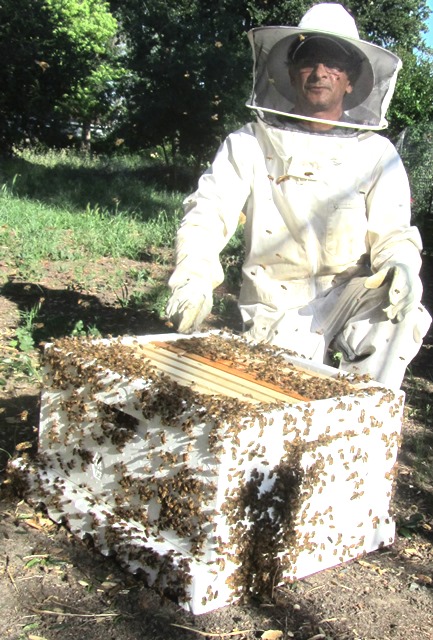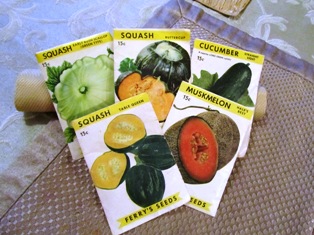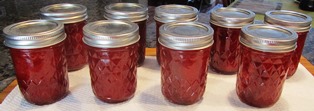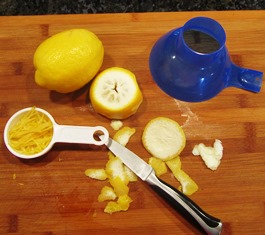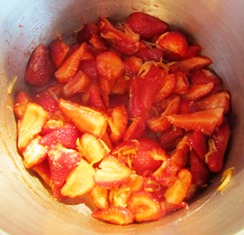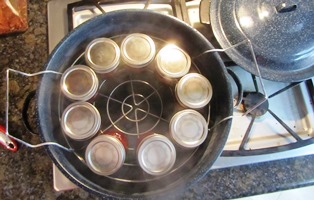Archive for the 'Uncategorized' Category
Catch Me if You Can
Tomorrow, the seat of my pants will be in the seat of a car for eight hours. The trip down south is to meet with my agent–the ever brilliant and beautiful Paula Munier who, in fact, sold not only my first novel but the entire series. She’s flying in from New England to speak at a conference. I’m sure she’ll enjoy the weather–the Pacific coast is warm and beautiful this time of year.
As my virtual book tour for A BEELINE TO MURDER soon will draw to a close, I’m getting reading for my other scheduled book giveaways and promos. I’ll keep you posted on those as well as book parties and public appearances.

Bees love all types of lavender, including the Spanish lavender pictured here. Plant it in pots, in a garden, or in a window box.
First up is the Mini-makers Fair at Barnes and Noble Bookstore in Walnut Creek November 6, 7, and 8. I’ll be taking the 5:00 p.m. slot. I’ll be demonstrating how to make herb sachets, discussing favorite foods of honeybees, and signing copies of my debut novel. Stop by and say hi.
Check back here for more updates through November and December.
Detecting and Dealing with Robber Bees and Wasps
In autumn when there are few nectar sources for the bees, you might see more bees out looking for food. Wasps will be about, too, since their queens must hibernate over the winter and will leave the colony; itself collapses. This means that lots of bees are looking for shrinking nectar sources. Stealing honey from a neighbor’s hive is a distinct possibility.
How will you know that bees and/or wasps are attempting to invade your hives? Robber bees and wasps will not fly directly in or the resident bees will attack. Instead, the robbers will approach from the sides. They may also fly in a zigzag pattern.
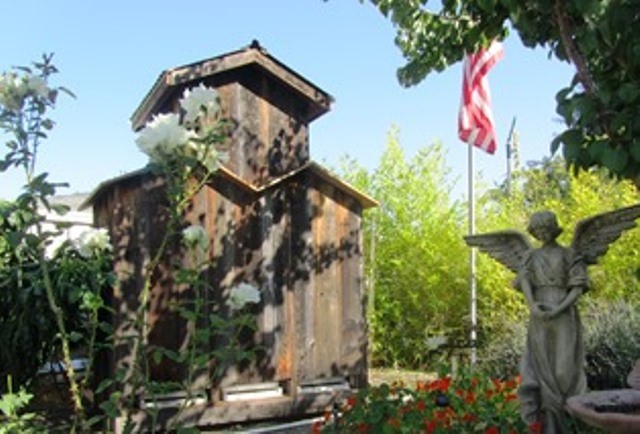
Our three-sided bee house with rear access allows easy hive inspections. It holds three hives and keeps the hives dry in rain.
What to do if you suspect robbers. The best course of action would be to insert into the opening of the hive a wooden board that has a small rectangular opening or hole in it. This effectively reduces the size of the entrance, making it easier to defend.
Hives with small numbers of bees won’t have the capability to defend a large entrance opening, so it makes sense to insert an entrance reducer board.
In the winter, the entrance reducer board will also help to keep out inclement weather like rain and snow as well as reduce drafts.
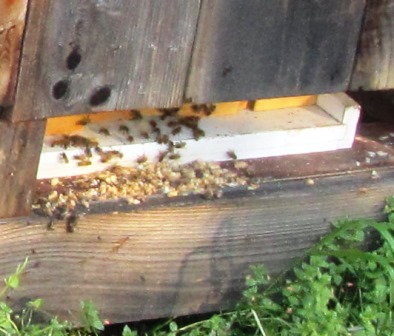
The reducer board (the yellow wooden insert in the white hive) reduces the size of the of the hive opening.
I confess that I don’t know how beekeepers care for their hives in other parts of the country. My knowledge comes from my experience keeping my own bees in the East Bay’s microclimate where the summers are hot, and the winters are typically cold and rainy.
I’ve also learned a lot from my beekeeper neighbor whose father was a beekeeper in the mountains of Lebanon. Over the last five years, this neighbor has generously shared his knowledge with me as we’ve worked on our respective hives together.
Killer Bees Found for the First Time in the East Bay
Global warming might be responsible for our extreme summer heat and the multi-year drought in the Bay Area. It might also explain the presence of killer bees, too. For the first time, U.C. San Diego scientists tracking the Africanized honeybees have found them here in the East Bay city of Lafayette.
The Oakland Tribune suggests the Africanized honeybees are docile unless their hive is threatened. Otherwise, the Africanized or “killer bees” are of similar temperament and have a similar sting as the European honeybees. See, http://www.insidebayarea.com/breaking-news/ci_28892198/killer-bees-detected-lafayette-bay-area-first-time?source=rss
The Africanized bees were bred with European honeybees in Brazil in 1956 to produce a honeybee better suited to Brazil’s climate. The bees escaped their containment, bred with European bees and spread.
The Africanized bees breeding with European honeybees quite possibly means the resulting bees may have a stronger resistance to one of diseases believed responsible for European bee die-offs and colony collapse disorder.
Widely published stories today tell us that the killer bees have been detected in Briones Regional Park in Lafayette, only ten miles from where I keep bees on the Henny Penny Farmette.
Researchers from U. C. San Diego have tracked the bees throughout the state. Likely more than one colony has been established here. But whether or not the bees stay remains to be seen. See, http://www.sfgate.com/bayarea/article/Killer-bees-found-in-the-Bay-Area-for-the-6535892.php
Bees prefer warmer, drier habitats, so they may not stick around. The strong El Nino forecast for this winter could bring much needed rain to the Bay Area and plunging temperatures to the freezing mark.
Africanized bees swarm relentlessly when they perceive a threat. If you are out walking and notice bees foraging on wildflowers, become vigilant. They may not bother you. But do observed them. Don’t swat at them, it will antagonize the bees.
If they start moving toward you, run to at least 100 yards away. Retreat indoors if possible. Don’t think you can escape by jumping into a lake or pool. Researchers say the killer bees have been known to wait above the water.
To read an in-depth analysis of the Africanized honeybee, see http://www.library.ca.gov/crb/99/notes/v6n2.pdf.
To curl up with a cozy mystery that features gentle honeybees, check out my newest novel, A BEELINE TO MURDER: http://www.amazon.com/s/ref=nb_sb_noss?url=search-alias%3Dstripbooks&field-keywords=Meera+Lester&x=0&y=0
Bougainvillea Vines Are Valued for Their Vibrant Color
If you’re looking for something that gives dense cover with green leaves and has prolific flower production, think about planting some bougainvillea vines. After my husband recently picked up four bougainvilleas in gallon-pots from our local nursery where the plants were on sale, we planted them around the front porch.
When you buy them in pots during spring and summer, you can pick bract color. The nearly inconspicuous blooms are surrounded by large, vibrantly colored bracts. Color choice ranges from red, orange, pink, fuchsia, deep purple, and white.
You’ll need to protect these evergreen shrubby vines where frost is expected. They’ll benefit from being moved to a warm wall. In fact, bougainvillea will thrive in the warmest parts of the garden. That said, they may even need a little shade protection in extremely hot areas.
Since the roots aren’t interwoven tightly in a root ball, you’ll want to plant them with care or slice the sides of your plastic gallon pot a half-dozen times, fold back, and plant pot and all in the planting hole.
Spring and summer are the best times to fertilize. Prune to renew the plant in the spring after the danger of frost is over. Many bougainvillea plants are tall growing varieties but you can also find some considered low- to medium-growing shrubs. These vines are show-stoppers with curb appeal and an even better value when you get them discounted at your local plant nursery.
Backyard Gardeners and Farmers Have a Choice
We gardeners and farmers have a choice when putting in our gardens, fields, and orchards. We can choose open-pollinated, heirloom seeds, hybrids seeds, or GMO seeds. I much prefer the old-fashioned way of seed-saving and sharing of open-pollinated, heirloom varieties.
On our farmette, we routinely save seed from plants we grow in one season and use them during another. We have picked apricots from our backyard trees, saved the seeds, and grown new trees that (this year) bore fruit.
We’ve exchanged seeds with our neighbors who also keep organic gardens and prefer open-pollinated seeds. Seeds that are hybrid and/or GMO usually are patented, meaning scientific companies or growers own those patents.
Open-pollinated seeds do not carry patents and remain available to all of us to plant and replant.
Gathering seeds from the plants one grows is how our grandparents did it. I go around plucking seed heads from cosmos, purple cone flower, and the hardened seeds of nasturtiums when the flowers have faded. I’ve taken cuttings of all my roses and have been given clips from friends and neighbor’s bushes and now plenty of roses to line walkways and fill a garden.
This year, an apricot tree that we started two years ago after we ate the fruit and planted its seed, bore beautiful cots that I turned into jam. I’ve got a bountiful crop of onions (red and yellow) and garlic and peppers this year from last year’s seed. The cycle goes on.
The acronym GMO stands for “genetically modified organism.” The phrase means that scientists have used recombinant DNA technology to create the seed. In some cases, the purpose is to create seeds with pesticides spliced into their DNA to repel pests.
Some gardeners see this process by chemists, scientists, and researchers working of large petro-chemical companies as a dangerous venture into biological processes that have a long evolutionary history. Further, the concern encompasses the potential negative ramifications of genetically engineering a plant–what farmer wants to handle seed (much less eat the plant) that has warning labels about pesticides integrated into the seeds?
If gardeners stick with open-pollinated seeds and participate in seed saving and sharing, together we can ensure our Earth’s biodiversity continues. The other prospect is scary. Many species and cultivars of plants are no longer available. They are no longer being grown. Some have become extinct.
Simple Strawberry Jam
I visited the Clayton Valley Farmer’s Market on Saturday and picked up six baskets of large strawberries trucked up from Watsonville, about a two-hour drive from my farmette.
Of the various cities claiming to be the strawberry capital of the world, Watsonville surely must rank as number one because it produces tons of berries to support its claim–California produces eighty percent of strawberries in America. Many, if not most, come from Watsonville.
Those berries in the green plastic baskets at the farmer’s market were huge and delicious and sweet. Perfect for making into jam. Strawberry jam, seemingly, is everyone’s favorite, and this year I’m making some extra batches.
The recipe is quite simple, with only five ingredients.
STRAWBERRY JAM
Ingredients:
6 1/2 cups of washed, sliced strawberries (about 2 quarts, plus a little more)
1/4 cup thinly sliced lemon peel
7 1/2 tablespoons powdered pectin
1 tablespoon of lemon juice
6 cups granulated sugar
Directions for Preparing Jars:
Place nine jars in the dishwasher.
Simmer the rings and lids in a skillet on low heat.
Fill the hot-water canner with water enough to cover the jars by two inches. Bring the water to a boil.
Directions to Make Jam:
Slice the lemon peel off and remove any remaining white membrane from the peel.
Slice the lemon peel into thin strips.
Place lemon peel in a small pan, cover with water, and boil for five minutes.
Drain the water off the lemon peel.
In a large pot, combine lemon peel, strawberries, pectin, and lemon juice. Bring to a boil.
Stir in the sugar until it is dissolved and then bring the pot to a roiling boil.
Boil hard for 1 minute, stirring constantly to avoid the jam sticking to the bottom of the pan.
Remove the jam pot from heat and skim off any foam as needed.
Remove the jars from dishwasher and turn upside down on a paper towel. Before filling the jars, wipe around the jar mouth to remove wetness and turn upright to fill.
Ladle the hot strawberry jam into each jar, leaving 1/4-inch head space. Wipe any jam spilled on the jar lip that might void a good seal. Then set the two-piece caps in place and screw tight. Process in the hot-water canner for 15 minutes. Makes 9 jars.
Sixty Pounds of Honey, Death of Some Drones, and a New Swarm
I opened my hives this past Sunday with the help of my world-class beekeeper neighbor. We checked on the the condition of eggs, the number of new queens, the growth of baby bees, the presence of mites (none detected), and the amount of honey (lots).
The male bees (the drones) over the last weeks have been engaged in some crazy flight patterns in front of the hive as the mating of the queen takes place. The old queen has done her egg laying and the hives have lots of babies with nurse maids and other worker bees. From the hives comes the clearly audible sound of humming and the fragrant scent of honey.

The drone (male bees) are vital for mating with the queen; after that, they are unnecessary and are eliminated
The drones are not now needed and the workers in the colony are doing away with them. I found a stack of drones at the front door of the hive this morning. Strange sight to see, indeed. But no more so than the many queen houses (formed from honeycomb by the worker bees). These houses are where the new queens are nourished; each contains royal jelly.
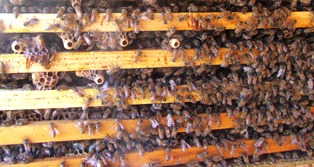
The tubular circles are the houses where the baby queens will be cared for by the workers. The houses contain royal jelly for the feeding of the new queens
My neighbor told me to wait three more weeks to take honey, but since I didn’t take any honey during the fall/winter and there were huge stores of it in my hives and coupled with the fact that there’s a plethora of flowers now to provide pollen for the bees, we decided it would be okay to remove some frames. So, I took six frames (weighing roughly ten pounds each) from the hives.
The honey I harvested has a pale lemony color–significant for the wildflowers and almond and fruit tree blossoms from which the bees collected the pollen to make that honey. In the fall, the honey is darker and earthier tasting, thanks to pollen from the star thistle and eucalyptus blooms.
When we had finished with my hives and walked back to my neighbor’s house, we spotted a swarm overhead. We grabbed the pots and wooden spoons and started banging. The bees took refuge in the tall pepper tree and that’s where my neighbor rescued them. In all, it was quite a spectacular Sunday!
Time Out to Review My Copy-edited Manuscript
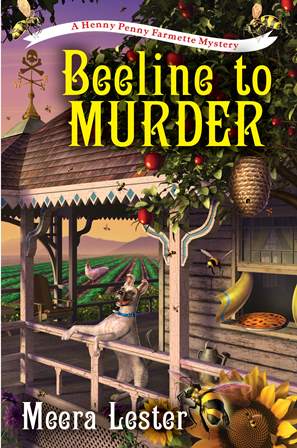
My debut novel, the first in a series of three cozy mysteries set against the backdrop of the Henny Penny Farmette
You may have noticed fewer blogs in recent days. And for good reason–my debut novel has just been copy-edited and I’m busy doing the the revisions.
I enjoy editing, so this is not only fun, but a learning experience for me. My attitude is to always try to learn as much as I can as I go through any new process. My editor is a dream and the copy editor is expert at what she does for authors’ books. I’m just plain lucky to be working with such talent.
I will be checking back soon with farmette goings-on. I have chicken issues that scream for my attention right now. The Rhode Island Red got a splinter in her foot and was limping around until I finally caught her. My husband removed the splinter and we treated her wound with antibiotic ointment.
Today, she seems fine, but another chicken has health problems. I’ve separated her from the rest and will be closely watching her.
So, I’m taking a little time away from all the farmette tasks to focus on the copy-edited manuscript. I want my readers to love the story of my sleuth, her coterie of friends, and the murder of the small town’s beloved pastry chef, Jean-Louis Bonheur. The book is in the pipeline and this is just one phase of the process. More on this to come later.
Ginger Tea for Colds and Flu
I’ve caught it . . . that nasty little bug affecting the throat and gut. Despite my best hygienic efforts at not catching the malady that many of my friends have recently endured, I have come down with it.
It started as a scratchy sore throat. Then a queasy stomach. Hoarseness and discomfort when swallowing followed. And the queasiness intensified to the point where even the sight of food sickened me. Oh, joy! Just what I didn’t want for the upcoming Thanksgiving week!
It’s always a good idea when you’re coming down with a cold or flu to increase your intake of fluids–herbal teas, juice, water, and popsicles. My former Chinese Tai Chi teacher advocated ginger tea to treat this type of malady; it’s my favorite home treatment for colds and flu.
Honey soothes the inflamed throat passages. Ginger settles the stomach. In fact, ginger has been used medicinally for 2,000 years in China to treat stomach upset, nausea, flatulence, and diarrhea.
GINGER TEA WITH HONEY
Ingredients:
1.5 inches of peeled and sliced fresh ginger root (about 1/2 cup)
5 to 6 cups of water
optional: 1/2 lemon, washed and sliced
optional: 2 sticks of cinnamon
honey or brown sugar, to taste
Directions:
Pour the water into a sauce pan.
Drop in the slices of ginger. Optional: add slices of lemon and cinnamon.
Simmer for 10 minutes.
Pour tea into a cup.
Stir in honey or brown sugar to sweeten.
Enjoy.
Try Having a Cup of Tea with These Dogs
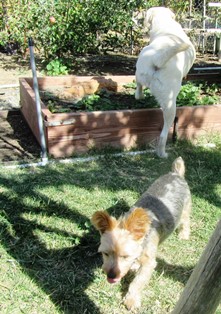
Remington, the white, short-haired lab, is trouncing over the strawberries, while Moose has his sights set on the chickens
I just wanted a nice cup of tea and to sit on the grass and sip it while listening to the birds and watching my bees and chickens. Fat chance. It would take five minutes flat for my daughter’s little dog Moose to knock over the cup, spill the tea all over me, and then traumatize my chickens so badly that their egg-laying is now out of wack; they’re just squatting and dropping.
As a favor to my lovely daughter and her family, I agreed to dog sit on my farmette for four days. My daughter assured me the two family pets would enjoy four days of freedom to romp around our acreage despite one of her dogs being a little high strung. His breed used to chase rats, she said. I didn’t make the correlation. It didn’t seem to matter then.
I reminded her that my bees and chickens both forage freely over the land. The chickens would necessarily have to remain in their chicken run during that period since the dogs might chase them. The bees probably wouldn’t bother the dogs, but I’d take the name of her vet, just in case. Of course, the dogs might not actually like it here.
In retrospect, I believe I underestimated my concerns. Oh, the dogs seem happy enough; it’s my sanity I’m worried about.
The Irish lab named Remington has had some professional training. He is a lovely, well-behaved gentleman. I enjoy him and wish I could same the same for the small dog with the mighty name of Moose who is high-strung, has allergies, and arrived with special gluten-free food, his round bed, and a bag of medications, including a vet-prescribed tranquilizer.
Moose barks a lot. It’s an annoying high-pitched bark. In the yard yesterday, when he wouldn’t stop, I heard my neighbor barking back . . . and that’s just ridiculous!
I thought Moose was going to have a meltdown when he discovered the chickens, barking at the highest decibel he could muster, running the length of the chicken run in one direction with the chickens one step ahead on the inside their poultry-wire pen before hitting the wall where the dog and chickens reversed their direction.
I got half as many eggs yesterday and found two on the ground instead of in the nesting boxes. When the chickens free-range, they always return to the nesting boxes in the hen house to lay their eggs. It’s like they got so scared, they forgot not only where to go but how to properly lay their eggs. I hope things return to normal when the dog visit is over.
I decided to spend the day outside, doing chores like digging planting holes at the front of the property. Moose saw it as a game so as soon as my back was turned, he refilled the holes, pawing like a dog on a mission. I finally gave up on that. The shovel and rake seemed to scare him, so I put those away. And he didn’t like me playing ball with him or the other dog. So we quit on that, too.
By the day’s end though, both dogs seemed tuckered out. Both wanted to sleep in our room. The big dog contented himself in his bed on the floor (by my husband’s side of the bed), but the high-maintenance Moose threw himself onto my pillow, pulled my fleece bathrobe over his head, and nodded off like he owned the place.
When our alarm went off at four o’clock as it does every weekday morning, the yip-yip-yipping and chaos started all over again. Only three more long days and nights left.

Remi wasn’t the problem but with Moose frightening the chicken feathers off my hens, I draped the chicken run in sheets
I’m going to need a vacation when these four days are over. I just hope my chickens will resume their egg-laying schedule once I take the sheets down off the chicken run (I hung them so Moose couldn’t see the chickens) and I have the energy and some decent weather ahead to re-dig those planting holes. I look forward to having a cup of tea again, too, while I listen to the birds and quiet clucks instead of that shrill yip-yip-yip, amplified by by neighbor’s imitation of it. Ridiculous!
 Facebook
Facebook Goodreads
Goodreads LinkedIn
LinkedIn Meera Lester
Meera Lester Twitter
Twitter



